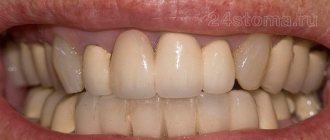Publication date: 03/19/2021
It seems that dental implantation takes a long time and it is impossible to make teeth turnkey in 1 day. However, innovative technologies and modern materials are capable of even this. Restoring lost teeth and making them indistinguishable from real ones is a feasible task for today’s medicine.
A beautiful, attention-grabbing smile is an indicator of health and status. It gives self-confidence to its owner. But what to do if not all the teeth were saved, or most of them are destroyed or are subject to severe caries. In such cases, treatment and subsequent implantation come to the rescue. This way you can get your perfect smile back in 1 day.
Indications and contraindications for installing implants in one day
This type of prosthetics allows you to either restore an entire row of teeth or make a prosthesis for just one tooth. This method is recommended for:
- periodontal disease
- irritation of bone tissue
- receding gums
- complete absence of teeth
This technology allows you to insert teeth in one day and immediately return a beautiful smile and the ability to eat comfortably.
One-time implantation is especially good in cases of complete or almost complete absence of teeth, when there is no time for a long wait and you want to quickly return to a full life.
There are certain situations in which implantation in one day is not possible. A preliminary examination will help identify these indications, without which medical intervention should not begin. Contraindications to dental implantology are:
- advanced osteoporosis
- oncological diseases
- connective tissue pathologies
- poor blood clotting
- immune system disorders
- decompensated diabetes
- acute infectious diseases
- pregnancy and lactation
If the above indications are present, the doctor will recommend an alternative method of restoring the dentition.
Express technologies
Installing teeth in 1 day has become possible thanks to modern technologies that allow you to automate and optimize the dentist’s work, as well as reduce its volume. Let's look at the main ones.
CAD/CAM
CAD/CAM technology, which stands for computer-aided design, began to be used in dentistry just a decade ago. The essence of this technology for dental prosthetics in one day is as follows: based on a 3D model of an orthopedic structure designed on a computer, elements for prosthetics are manufactured using a milling machine.
Manufacturing stages:
- taking an impression
- placing it in a special scanner and creating a model
- frame milling
- covering the frame with ceramic mass
- baking
Provided that the clinic has its own dental laboratory, all these stages - plus the installation of the structure - are carried out by a specialist in one visit, which allows you to make teeth in one day. The CAD/CAM system gives the doctor the ability to fully control the design stage and make changes if necessary. Automation of the process eliminates the human factor, and therefore the risk of error - even with a high level of design complexity. As a result, the patient receives high-quality orthopedic treatment in one day, the results of which will last for a long time.
CEREC
The innovative technology of artistic dental restoration CEREC is a German development. Thanks to this technology, today for many clinics in Moscow new teeth in one day are a standard service. The complex computer system includes a device for scanning the oral cavity, a computer for creating a three-dimensional model and a milling unit.
How it works?
- An intraoral scanner determines the boundaries of tooth damage and sends information to a computer.
- A 3D model is projected onto the monitor.
- Based on the model, the doctor creates a computer image of the future orthopedic design.
- A dental prosthesis is made on a milling module.
- The element is tried on and fixed in the oral cavity.
The CEREC 3D system allows you to produce crowns and other elements for dental restorations in a minimum time - with comfort for the patient - and perform dental prosthetics in 1 day instead of two or three visits. The main advantage: there is no need to make an impression of the teeth, which is extremely important if the patient has an increased gag reflex.
Implantation using a surgical template
Implantation is a responsible procedure, the success of which may be jeopardized due to the slightest deviation of the pin from the specified angle. The risk of failure helps to minimize the technology of implantological treatment using a template. It was thanks to her that it became possible to get new teeth in one day using implants. The template is a mouthguard made of acrylic, polymer plastic or transparent plastic, which is made on the basis of impressions. Next, the impression is processed by a scanner, the information is sent to a computer, and based on this data, an individual treatment plan is selected, including the shape and size of the implants, the angle of inclination and location in the jaw.
When installing teeth in 1 day using surgical template technology, the procedure time is reduced significantly, since the doctor can install the implants as accurately as possible without independently determining their desired position. For this treatment protocol, temporary crowns can be prepared in advance and placed on the implants at the same time.
Implantation without bone grafting
Common reasons why a few years ago a patient would not have been able to get teeth done in 1 day using implantation are osteoporosis (bone disease) and lack of bone tissue. Bone loss is common when teeth are missing for several months or more. Today, special treatment protocols are used to solve this problem, even with severe bone atrophy.
The most popular methods: implantation using implants of a special shape and length, which allows them to be secured in deep and durable layers of bone; with a narrow bone, the solution may be to split the alveolar ridge - a long process of bone is split using a special operation, resulting in a space sufficient for the installation of a pin.
Stages of treatment
Implantation in 1 day is prosthetics immediately after the installation of implants. The issue of aesthetic and practical function of teeth is resolved in a short time. This operation does not require bone grafting. Implants can be installed not only in the spongy substance, but also in deeper layers of bone. In addition, the pins can be placed at an angle. This technology allows you to avoid injury to nerves, blood vessels and paranasal sinuses.
The installation of implants is carried out in one visit to the dentist, but to achieve the final result, this procedure requires preparatory measures. The whole operation takes place in several stages:
- At the first session, the doctor conducts diagnostics, determines the current condition of the patient’s teeth, possible contraindications, and performs a computed tomography scan. If preliminary treatment is necessary, it must be carried out. Otherwise, it will not be possible to install new teeth. At the same appointment, a model of future prostheses is created. The waiting period for future implants ranges from 1 to 7 days. Next, the doctor chooses the method of performing the procedure, selects the pins and makes the crowns that will be installed.
- The second stage is the work of installing the metal pins themselves. It is performed under anesthesia in one procedure. At the site where the implants are installed, an incision is made in the gum and pins are screwed into the prepared recess. Then the gum is sutured. Next, a temporary prosthesis is placed on the implanted implants. It is made of acrylic, so it is quite light, which contributes to comfortable wear and rapid healing.
The permanent prosthesis is installed 6-12 months after implantation. This time is enough for the implant to fuse with the bone.
What are the advantages of one-stage implantation?
Firstly, with its help you can close the gap formed due to tooth loss with a reliable and aesthetic design and not be embarrassed about your smile. Secondly, a temporary dental crown immediately installed on the implant allows you to create an ideal gum contour and avoid the appearance of a very common defect during delayed implantation - black triangles - spaces between the artificial tooth and adjacent natural teeth not covered by soft tissue. And thirdly, one-stage implantation reduces treatment time by approximately half.
To attract clients, some clinics often call the one-stage method express implantation and promise to completely restore the patient’s tooth in one day. But you need to understand that during one appointment, the doctor can load the implant only with a temporary crown, and install a permanent one three to four months later. Loading an implant that is not yet fully stabilized in the bone with a fairly heavy permanent structure threatens, firstly, with its rejection, and secondly, with the occurrence of a rather dangerous defect. The fact is that after the operation the soft tissues are very inflamed and fit very tightly to the crown. After some time, the swelling subsides and a gap forms between the gum and the prosthesis, which is closed with a more suitable permanent crown. If you immediately install a permanent structure on the implant, the resulting gap will no longer be able to be closed. After some time, the gums will sink even more and expose the abutment, which will be very noticeable when you smile, and the bacteria accumulating on it will cause inflammation and, as a result, re-implantitis.
Which implantation method is best to use?
In modern dentistry, there are several methods of implantation with immediate loading. The most popular and affordable is all-on-4. With this protocol, the dentition is replaced with only four pins. Two of them are implanted vertically and two on the sides at an angle.
Using this technology, 12 dental units can be restored at a time. It is well suited for people who are missing all the teeth on one or both jaws. Or they have been preserved, but in such a condition that they only need to be removed. In this case, implantation and removal can be carried out in one session, and the pins can be installed in the holes remaining after extraction.
The all-on-4 protocol is feasible in case of good preservation of bone tissue and in the absence of gum damage. This method is also used for periodontitis and periodontal disease.
A more advanced method of all-on-4 prosthetics is the all-on-6 protocol. The difference lies in the number of pins implanted. The use of two additional implants increases the reliability of the design as a whole. In addition, the use of all-on-6 is possible even with severe atrophy of the spongy substance due to the fact that the pins are installed in a deeper layer of bone.
Features of dental implants
Implants for one-stage prosthetics have the same parts as for two-stage prosthetics:
- The bony part that is fixed in the hard tissues of the jaw.
- An abutment or head that protrudes above the gum and serves as a support for the crown.
A feature of one-stage implants is their monolithic nature. Firstly, this design allows for more aggressive implementation, performing bone spreading in difficult cases. Thanks to this, these implants do not impose high demands on bone quality and can be used in those clinical situations where conventional protocols are either contraindicated or require additional interventions. With their help, you can avoid bone grafting and significantly reduce treatment time.
Secondly, from a functionality point of view, a monolithic structure is considered more reliable than a collapsible one. There are no problems with unwinding of the abutment head or neck fractures. The absence of microcracks significantly reduces the risk of bacterial complications and the development of peri-implantitis and bad breath.
As for the shape, one-stage implants are made in the form of a cone, with a thread applied to it, which has a high profile height, or, as it is also called, an aggressive design. Aggressive carving makes it possible to achieve sufficiently high stability of the structure even in bones with a spongy structure, up to osseointegration.
This shape also increases the functional area of the implant. For comparison, the surface area of a 4.5/12 mm one-stage implant corresponds to the cylinder of a 5.8/12 mm two-stage implant.
Another feature is the diameter of the required bone hole, which is much smaller than the diameter of the implant. In comparison, a 4.5mm design requires a 3mm hole. This feature allows implantation to be used on thin atrophied bones. During installation, the implant is screwed into the bone, thereby pushing it apart and compacting it. This process is called autospreading.
How durable are teeth in 1 day?
The service life of implants using the all-on-4 or all-on-6 method is 15-20 years. With good hygiene and regular visits to the dentist for checkups, these implants can last a lifetime.
They do not require special care. Regular brushing of teeth 2 times a day and rinsing the mouth is sufficient.
Typically, implant manufacturers provide a temporary or lifetime warranty on their products. In addition, some dentists provide a guarantee on their work. Therefore, if, with proper care and regular checks, problems arise, you will not have to pay to fix them.
The essence of the procedure
Restoring a smile in one visit to the dentist is an express implantation that is carried out simultaneously with tooth extraction. The implant is implanted so that a temporary crown can be placed immediately. It is durable, looks natural and successfully copes with all loads. And after a while, when the implant takes root, it can be replaced with a permanent crown made of metal ceramics or zirconium.
An implant that replaces a tooth root is made of titanium or its alloys. It is durable, biocompatible with body tissues, so it takes root well and does not cause allergies.
How to choose a specialist
The first thing you should pay attention to is the availability of diagnostic equipment in dentistry. If you were sent to another clinic for a CT scan of your teeth and oral cavity, you should think twice. Modern equipment should be in every serious medical center.
Second, no less important, is the doctor’s experience in the field of implantology. Due to the complexity of the process, the specialist must have experience in performing the operation in this particular direction. Before your consultation, try to educate yourself about the different methods of immediate loading implantation and ask enough questions to the specialist to assess his level of professionalism.
Materials
The use of the latest technologies allows us to quickly manufacture and install reliable, high-quality and beautiful dentures that will accurately imitate lost teeth:
- For the manufacture of immediate dentures, plastic, nylon, acrylics, and composite materials are used.
- Inlays for microprosthetics are made from high-quality durable filling materials.
- High-strength composites are used for direct veneering.
If you need quick dental prosthetics in Moscow, contact the PROFI-Dent clinic.
Implantation in one day: Top 5 myths and reality
- Myth No. 1.
All implantation work can be completed in one visit. Reality: the process of implantation actually takes place in one visit. However, to make the diagnosis, CT scan and impression, one or two more appointments are needed. - Myth No. 2.
Implantation is contraindicated in case of periodontal disease. Reality: implantation for periodontal disease and periodontitis is rather an indication or even the only way out to have a normal dentition. - Myth No. 3.
Dental implantation is painful. Reality: Implant placement always takes place under local anesthesia. Particularly impressionable patients can perform it under sedation and wake up when everything is ready. - Myth No. 4
. Implantation is expensive. Reality: There are budget and luxury options on the implant market. In addition, over the years the service has become more and more accessible, and many clinics hold promotions for implantology services. - Myth No. 5.
An implant is a foreign body; the body will definitely reject it. Reality: modern implants are made of biocompatible materials and take root in 99% of cases.
Dentures - modern reality
Such a service as dental prosthetics in Moscow is provided by many dentists, but not every one of them can provide truly high-quality care.
To restore lost teeth quickly and with maximum results, a number of conditions are necessary:
- participation of a competent and experienced orthopedic dentist;
- correct choice of design and its production strictly according to technology;
- use of high-quality, biocompatible materials;
- application of the latest production technologies.
The PROFI-Dent clinic provides prosthetics in Moscow at the highest level of quality.
Cost of instant implantation
Below is a table with the prices of some dental clinics where you can get your teeth done in one day in Moscow.
| Clinic | All-on-4 | All-on-6 |
| Implant Expert | from 200,000 rub. | from 250,000 rub. |
| D Studio | from 179,000 rub. | from 249,000 rub. |
| Akademstom | from 110,000 rub. | from 170,000 rub. |
| New white smile | from 145,000 rub. | from 185 00 rub. |
| Novadent | from 189,000 rub. | from 276,000 rub. |
Prices
| Service | Price |
| Installation of a zirconium dioxide bridge supported by ASTRA-TECH implants (Sweden) | from 36,000 rub. |
| Installation of a zirconium dioxide bridge supported by Imlantium implants (South Korea) | from 36,000 rub. |
| Installation of a zirconium dioxide bridge supported by Straumann implants (Switzerland) | from 36,000 rub. |
| Dental prosthetics with complete removable plate dentures (immediate denture) | from 8,000 rub. |
To avoid possible misunderstandings, please clarify the cost of services in clinics with the administrator or during a consultation with a doctor. Prices on the website are not a public offer.
Sign up for a consultation
Questions and answers
The teeth in a row are in poor condition or missing; can they be replaced with implants?
All the teeth in a row are in poor condition or missing; is it possible to replace all the teeth with implants?
It all depends on the condition of the remaining teeth. If they are not hopeless and can be treated, then removing them to install implants is not recommended. If teeth are to be removed, you can replace them with dental implants or a full bridge on implants, in which case the one-stage BOI implantation method is suitable for you
I am missing seven teeth on my lower jaw - three and four on each side. I’ve heard about the “all-on-four” method, does it have any contraindications?
I am missing seven teeth on my lower jaw - three and four on each side. I heard about the all-on-four method and thought it would be a great option for me. But here’s the catch: it turns out that the remaining 5 teeth in front are a contraindication for its use? What to do? Walk with a removable denture or pull out these teeth and install a general denture on implants.
The All-on-4 prosthetic method is truly in demand among patients who are missing a large number of teeth in a row. It allows minimizing costs, time and physical discomfort. In one visit, a person is implanted with 4 implants in one jaw. During the second visit, a general prosthesis is fixed on them (fastened with strong matrix locks). In your case, it is important to objectively assess the condition of your remaining teeth. If there are problems, the objectively best solution is to remove and apply All-on-4. If they are in good condition, consider the option of implant prosthetics separately on each side of the lower jaw. It may be possible to restore separately sections of the chewing zone using the same four implants (two implants and a bridge on them - on each side). SIMPLADENT specialists will answer all questions by phone: + 800 333-53-41
Other questions
Other jobs
How tightly is the prosthesis fixed?
Chewing immediately after implant surgery seems like a fairy tale to patients. Moreover, this prospect frightens many, as there is a fear that the entire structure will become loose.
But the dentures are fixed securely. And this is achieved, firstly, through the selection of special implants - they are designed specifically for these protocols and have a high strength of primary fixation. Such implants compact bone tissue when screwed in, and their surface is coated with bioactive substances that accelerate the growth of new cells. Secondly, they are placed in the bone at an angle - this way they distribute the load over a larger area. Thirdly, the choice of place for implantation also affects the strength - even at the 3D modeling stage, the doctor selects suitable areas of the bone. And finally, the prosthesis itself with a metal base plays the role of a splint - it connects and immobilizes all the implants.
Therefore, chewing does not interfere, but, on the contrary, helps the fusion of implants with the jawbone - pressure and load stimulate the natural growth and renewal of bone tissue cells, almost as if there were living roots in it. That is why, in the case of complete absence of teeth, punctures with the immediate installation of a fixed prosthesis, which rests on implants, are much better than if the implants were left alone until they completely fused with the bone - this process (engraftment or osseointegration) in the second case takes longer, more difficult and less predictable.
Four implants may be sufficient to support a full jaw denture. Photo: Smile-at-Once









